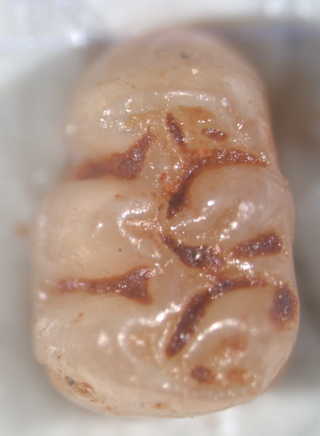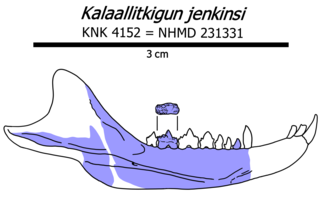
The molars or molar teeth are large, flat teeth at the back of the mouth. They are more developed in mammals. They are used primarily to grind food during chewing. The name molar derives from Latin, molaris dens, meaning "millstone tooth", from mola, millstone and dens, tooth. Molars show a great deal of diversity in size and shape across the mammal groups. The third molar of humans is sometimes vestigial.

In mammalian oral anatomy, the canine teeth, also called cuspids, dogteeth, eye teeth, vampire teeth, or fangs, are the relatively long, pointed teeth. In the context of the upper jaw, they are also known as fangs. They can appear more flattened, however, causing them to resemble incisors and leading them to be called incisiform. They developed and are used primarily for firmly holding food in order to tear it apart, and occasionally as weapons. They are often the largest teeth in a mammal's mouth. Individuals of most species that develop them normally have four, two in the upper jaw and two in the lower, separated within each jaw by incisors; humans and dogs are examples. In most species, canines are the anterior-most teeth in the maxillary bone. The four canines in humans are the two upper maxillary canines and the two lower mandibular canines. They are specially prominent in dogs (Canidae), hence the name.
Ferugliotherium is a genus of fossil mammals in the family Ferugliotheriidae from the Campanian and/or Maastrichtian period of Argentina. It contains a single species, Ferugliotherium windhauseni, which was first described in 1986. Although originally interpreted on the basis of a single brachydont (low-crowned) molar as a member of Multituberculata, an extinct group of small, rodent-like mammals, it was recognized as related to the hypsodont (high-crowned) Sudamericidae following the discovery of additional material in the early 1990s. After a jaw of the sudamericid Sudamerica was described in 1999, these animals were no longer considered to be multituberculates and a few fossils that were previously considered to be Ferugliotherium were assigned to unspecified multituberculates instead. Since 2005, a relationship between gondwanatheres and multituberculates has again received support. A closely related animal, Trapalcotherium, was described in 2009 on the basis of a single tooth.

The maxillary central incisor is a human tooth in the front upper jaw, or maxilla, and is usually the most visible of all teeth in the mouth. It is located mesial to the maxillary lateral incisor. As with all incisors, their function is for shearing or cutting food during mastication (chewing). There is typically a single cusp on each tooth, called an incisal ridge or incisal edge. Formation of these teeth begins at 14 weeks in utero for the deciduous (baby) set and 3–4 months of age for the permanent set.

The maxillary lateral incisors are a pair of upper (maxillary) teeth that are located laterally from both maxillary central incisors of the mouth and medially from both maxillary canines. As with all incisors, their function is for shearing or cutting food during mastication, commonly known as chewing. There are generally no cusps on the teeth, but the rare condition known as talon cusps are most prevalent on the maxillary lateral incisors. The surface area of the tooth used in eating is called an incisal ridge or incisal edge. Though relatively the same, there are some minor differences between the deciduous (baby) maxillary lateral incisor and that of the permanent maxillary lateral incisor. The maxillary lateral incisors occlude in opposition to the mandibular lateral incisors.
Dental anatomy is a field of anatomy dedicated to the study of human tooth structures. The development, appearance, and classification of teeth fall within its purview. Tooth formation begins before birth, and the teeth's eventual morphology is dictated during this time. Dental anatomy is also a taxonomical science: it is concerned with the naming of teeth and the structures of which they are made, this information serving a practical purpose in dental treatment.
This is a list of definitions of commonly used terms of location and direction in dentistry. This set of terms provides orientation within the oral cavity, much as anatomical terms of location provide orientation throughout the body.

Ambondro mahabo is a mammal from the Middle Jurassic (Bathonian) Isalo III Formation of Madagascar. The only described species of the genus Ambondro, it is known from a fragmentary lower jaw with three teeth, interpreted as the last premolar and the first two molars. The premolar consists of a central cusp with one or two smaller cusps and a cingulum (shelf) on the inner, or lingual, side of the tooth. The molars also have such a lingual cingulum. They consist of two groups of cusps: a trigonid of three cusps at the front and a talonid with a main cusp, a smaller cusp, and a crest at the back. Features of the talonid suggest that Ambondro had tribosphenic molars, the basic arrangement of molar features also present in marsupial and placental mammals. It is the oldest known mammal with putatively tribosphenic teeth; at the time of its discovery it antedated the second oldest example by about 25 million years.

Brachytarsomys mahajambaensis is an extinct rodent from northwestern Madagascar. It is known from nine isolated molars found in several sites during fieldwork that started in 2001. First described in 2010, it is placed in the genus Brachytarsomys together with two larger living species, which may differ in some details of molar morphology. The presence of B. mahajambaensis, a rare element in the local rodent fauna, suggests that the region was previously more humid.
LACM 149371 is an enigmatic fossil mammalian tooth from the Paleogene of Peru. It is from the Santa Rosa fossil site, which is of uncertain age but possibly late Eocene or Oligocene. The tooth is poorly preserved and may have been degraded by acidic water or because it passed through a predator's digestive tract. Its largest dimension is 2.65 mm. It is triangular in shape and bears six cusps that surround the middle of the tooth, where there are three basins (fossae). Crests connects the cusps and separate the fossae. The microscopic structure of the enamel is poorly preserved.
Trapalcotherium is a fossil mammal from the Cretaceous of Argentina in the family Ferugliotheriidae. The single species, T. matuastensis, is known from one tooth, a first lower molar. It is from the Allen Formation, which is probably Maastrichtian in age, and was first described in 2009. The tooth bears two rows of cusps, one at the inner (lingual) side and the other at the outer (labial) side, which are connected by transverse ridges separated by deep valleys. This pattern is reminiscent of Ferugliotherium, a gondwanathere mammal from similarly aged deposits in Argentina, and Trapalcotherium is therefore recognized as a member of the same family Ferugliotheriidae. Ferugliotheriidae is one of two families of gondwanatheres, an enigmatic group without close relationships to any living mammals.

Agathaeromys is an extinct genus of oryzomyine rodents from the Pleistocene of Bonaire, Netherlands Antilles. Two species are known, which differ in size and some details of tooth morphology. The larger A. donovani, the type species, is known from hundreds of teeth that are probably 900,000 to 540,000 years old, found in four localities. A. praeuniversitatis, the smaller species, is known from 35 teeth found in a single fossil site, which is probably 540,000 to 230,000 years old.

Cricodon is an extinct genus of trirachodontid cynodonts that lived during the Early Triassic and Middle Triassic periods of Africa. A. W. Crompton named Cricodon based on the ring-like arrangement of the cuspules on the crown of a typical postcanine tooth. The epithet of the type species, C. metabolus, indicates the change in structure of certain postcanines resulting from replacement.

Alemoatherium is an extinct genus of prozostrodontian cynodont which lived in the Late Triassic of Brazil. It contains a single species, A. huebneri, named in 2017 by Agustín Martinelli and colleagues. The genus is based on UFSM 11579b, a left lower jaw (dentary) found in the Alemoa Member of the Santa Maria Formation, preserving the late Carnian-age Hyperodapedon Assemblage Zone. Alemoatherium was among the smallest species of cynodonts found in the rich synapsid fauna of the Santa Maria Formation. Its blade-like four-cusped postcanine teeth show many similarities with those of dromatheriids, an obscure group of early prozostrodontians.

Arisierpeton is an extinct genus of synapsids from the Early Permian Garber Formation of Richards Spur, Oklahoma. It contains a single species, Arisierpeton simplex.
Kraterokheirodon is an extinct genus of enigmatic tetrapod, that was possibly an amniote, from the Late Triassic Chinle Formation of Arizona. The type and only species is K. colberti. Although it is known only from two large teeth, their shape is so unlike those of any other animal that Kraterokheirodon cannot definitively be classified under any known group of tetrapods. Its discovery also indicates that our understanding of Late Triassic tetrapod diversity is still incomplete, with Kraterokheirodon representing an otherwise unknown lineage of large tetrapod in western North America.

Kalaallitkigun is an extinct genus of haramiyidan mammaliaforms from the Late Triassic of Greenland. It contains a single species, Kalaallitkigun jenkinsi, which was described in 2020 from a partial dentary found in the Fleming Fjord Formation. More specifically, it was found in the mid-late Norian Carlsberg Fjord beds of the Ørsted Dal Member. It is the oldest of several mammaliaform species discovered in the Late Triassic sediments of Greenland. It is also the oldest mammaliaform with double-rooted teeth, and its pattern of tooth cusps help to clarify the evolution of haramiyidan teeth relative to their morganucodont-like ancestors.

Cretacladoides is a genus of chondrichthyan, possibly a falcatid, found in France and Austria. Known solely from teeth, mainly found in the Klausrieglerbach locality of Austria, it consists of two species, C. ogiveformis and C. noricum. Assuming a falcatid identity, it is the most recent member of the family, which otherwise became extinct at the end of the Carboniferous.

Santacruzgnathus is an extinct genus of small cynodonts from the Late Triassic (Carnian) Santacruzodon Assemblage Zone of Brazil. It contains one species, S. abdalai. Santacruzgnathus is known from a single partial lower jaw with four postcanine teeth, only one of which is well-preserved. Some features of the specimen, including the slender shape of the jaw and the incipiently double-rooted teeth, indicate that the animal was an early member of Prozostrodontia, a group that includes mammals and their close relatives.
Gansuselache is a genus of extinct elasmobranch in the order Hybodontiformes, comprising one species, Gansuselache tungshengi (monotypy) from Gansu Province, China. It is known from Fangshankou Formation, which previously interpreted as Permian in age, but reinterpreted as the Early Triassic in later study. A tooth remain tentatively assigned to this genus is also known from Late Permian strata of Poland.













